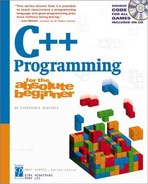Book Description
Using game creation as a teaching tool, this book not only teaches C#, it also teaches the fundamental programming concepts you need to grasp in order to learn any computer language. You will be able to take the skills learned in this book and then apply them to your own situation. Microsoft C# Programming for the Absolute Beginner is a unique book aimed at the novice programmer. Developed by computer science instructors, this series is the ideal tool for anyone with little to no programming experience.
Features
A fun approach to a difficult topic -- create games in C# as you learn the fundamentals
A gentle introduction into the world of programming
The CD includes all of the code and games from the book
Provides a firm foundation in programming principles
Table of Contents
- Dedication
- Acknowledgements
- About the Author
- Introduction
- Basic Input and Output: A Mini Adventure
- Branching and Operators: The Math Game
- Loops and Strings: The Pig Latin Program
- Objects and Encapsulation: The Critter Program
- Introducing the Critter Program
- Creating Methods to Reuse Code
- Creating a Menu
- Creating a New Object with the CritterName Program
- Adding a Method
- Creating the talk() Method for the CritterTalk Program
- Changing the Menu to Use the talk() Method
- Creating a Property in the CritterProp Program
- Making the Critter More Lifelike
- Summary
- Constructors, Inheritance, and Polymorphism: The Snowball Fight
- Creating a Windows Program: The Visual Critter
- Timers and Animation: The Lunar Lander
- Introducing the Lunar Lander
- Reading Values from the Keyboard
- Animating Images
- Using a Timer to Automate Animation
- Adding Motion
- Detecting Collisions between Objects
- Bouncing the Ball off the Sides
- Checking for Collisions
- Extracting a Rectangle from a Component
- Getting More from the MessageBox Object
- Coding the Lunar Lander
- Summary
- Arrays: The Soccer Game
- The Soccer Game
- Introducing Arrays
- Working with Arrays
- Designing the Soccer Game
- Designing Programs by Hand
- Building the Soccer Program
- Setting Up the Players
- Setting Up the Opponents
- Setting Up the Goalies
- Responding to Player Clicks
- Handling Good Shots
- Handling Bad Shots
- Setting a New Current Player
- Handling the Passage of Time
- Updating the Score
- Summary
- File Handling: The Adventure Kit
- Chapter Basic XML: The Quiz Maker
- Databases and ADO.NET: The Spy Database
